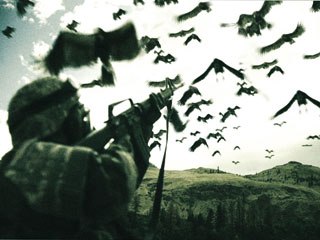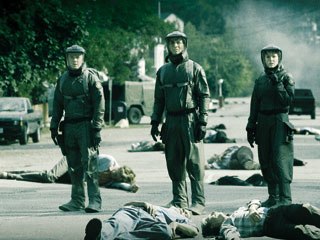Tara Bennett speaks with David Vána of UPP Prague about revisiting The Andromeda Strain as a recent A& E miniseries with lots of vfx demands.
While A&E's new doomsday miniseries, The Andromeda Strain, might take place on domestic soil, producers Ridley Scott, Tony Scott, Tom Thayer and David W. Zucker actually looked across the pond to find a vfx house to create the intricate visual effects needed to bring the project to life. UPP VFX and Post Production House, Europe's largest vfx facility in Prague, were hired to create all the visual effects for the four-hour, two-part miniseries based on Michael Crichton's novel about an extraterrestrial disease that threatens to wipe out humanity. The Andromeda Strain was also released this week on DVD from Universal Home Ent. David Vána, UPP vfx supervisor, recently talked with VFXWorld about the particular challenges of the production.
Tara Bennett: At four hours in length, how many shots did you have to create for The Andromeda Strain?
David Vána: For this TV movie we made approximately 900 vfx shots. This was challenging as we only had four months to complete the work.
TB: A lot of the film takes place inside the lab of the scientists working to stop the deadly "Andromeda" virus. How did you go about creating this microscopic killer?
DV: The virus was completely created in 3D using Maya. We had to use scientific references to create the virus at an atomic and molecular level -- specifically how this looked under a microscope. These shots are based on the latest scientific references and the director Mikael Salomon added creative elements to it. The specific design of the virus was selected from a number of options we created. And elements of the script dictated the specific movement of the virus.
TB: Animals in the film are also affected by the virus and in the testing process to stop it. Did those creatures fall to your department too?
DV: Yes. It was not possible to train the wild animals (buzzard, hawk, rabbit, snake, fishes…) for what was required for this movie, so we had to enhance their movement in CG. In some cases we had to prepare full animal animation. In the bird attack, all the birds are completely in CG. For the animation of birds we used particle system XSI. However, it was not possible in this software to accurately create the interaction between the birds and the actors. We had to animate them separately. To get the correct locations where birds hit the actors, we had to create dummy models of the actors. The most difficult part of this work was interaction with the actor's actions. We also added CG dust and smoke here which were created in Maya.
Another good example of the challenges presented by the creation of the animal movement is the scene where the snake attacks the rabbit. A real rabbit was shot on set. The trainer held the rabbit to the ground, simulating the attack. We then retouched the trainer's hand and introduced our CG snake.
TB: The miniseries also featured a large military contingent, so how much did you have to model or create for those sequences?
DV: A big cost consideration was the amount of aircraft required for the movie. We created the majority of planes and helicopters in CG and also made a lot of enhancements due to fighting scenes. A specific element of this was the combination of a real 1:1 scale cockpit with a CG F16 plane fuselage and the combination of the F16 crash with the atomic explosion and subsequent shock wave taking out the CG helicopter. Due to safety issues involving the stunt performer -- only the lower third of the helicopter was built to create the explosion. There were no real F16s available for shooting. We had two possibilities to use existing reference material from our databanks or to create our own F16 in 3D. We decided to go for our own model as this gave us much more flexibility to take in to account the various visual elements that Mikael was looking for. We are particularly happy with the scene where real footage of the pilot in the cockpit merged with our CG F16. For all helicopters and planes shots we used XSI software.
We also prepared the multiplication of helicopters for different scenes. Production had only one actual helicopter available. We used it as a reference for creating the additional helicopters seen in the movie.
TB: Did your work also include the ISS space station?
DV: Yes, we were also responsible for creating an artistic element of the ISS space station. We had a blank wall on which to create all of the graphs, visual screens, GPS monitors, etc. We also created the GPS screens on the pilot-less drones.
The ISS space station interior also had to have the Andromeda boxes in the foreground. We did these in 3D matte painting. In the background, we created a matte painting using the references of an actual space station. However, a lot of our references were merely to create inspiration. The final design and look of the screen design was the product of our creative design team.
TB: Was the robotic arm also part of your creative inspiration?
DV: The robotic arm in the ISS space station was also completely created in CG. We used references from real robots, but we had to be careful about the movement and space around the arm to function realistically. To create the realism of its function we had to be very specific about the number of moveable joints.
TB: How many artists did you have assigned to the project?
DV: During the project we had different staffing levels relevant to the demands for the project at that time. Of course, this required a lot of flexibility, which has become a daily life in UPP. In all, we had approximately 40 people working on this project.
Tara Bennett is an East coast-based writer whose articles have appeared in publications such as SCI FI Magazine, SFX and Lost Magazine. She is the author of the books 300: The Art of the Film and 24: The Official Companion Guide: Seasons 1-6.










